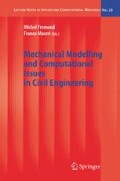Abstract
The implementation of plasticity models with general isotropic yield surfaces is discussed. The computation of the return map solution and the algorithm linearization are carried out by suitably exploiting the isotropic character of the elastic constitution and of the yield function; the consistent tangent tensor is given an intrinsic explicit representation and the relevant coefficients are provided. It is also addressed the implementation of the constitutive algorithm in the subspace defined by the plane stress condition. This is obtained only by specializing the three-dimensional formulation to a two-dimensional ambient space, with the result that the structure of the return mapping scheme and the formal expression of the consistent tangent tensor are preserved. The effectiveness of the approach is demonstrated by means of representative numerical simulations.
Access this chapter
Tax calculation will be finalised at checkout
Purchases are for personal use only
Preview
Unable to display preview. Download preview PDF.
References
J.C. Simo and T.J.R. Hughes. Computational Inelasticity. Springer, Berlin, 1998.
J.C. Simo. Numerical analysis and simulation of plasticity. In P.G. Ciarlet and J.L. Lions, editors, Handbook of Numerical Analysis, number VI. Elsevier Science, Amsterdam, 1998.
V. Palazzo, L. Rosati, and N. Valoroso. Solution procedures for J3 plasticity and viscoplasticity. Computer Methods in Applied Mechanics and Engineering, 191(8):903–939, 2001.
L. Rosati and N. Valoroso. A return map algorithm for general isotropic elasto/visco-plastic materials in principal space. International Journal for Numerical Methods in Engineering, 60(2):461–498, 2004.
J. Lubliner. Plasticity Theory. Macmillan, New York, 1990.
C. Truesdell and W. Noll. The non-linear field theories of mechanics. In S. Flügge, editor, Handbuch der Physik Band III/3. Springer, Berlin, 1965.
G. Del Piero. Some properties of the set of fourth-order tensors with application to elasticity. Journal of Elasticity, 3:245–261, 1979.
J. Lemaitre and J.L. Chaboche. Mechanics of Solids Materials. Cambridge University Press, Cambridge, 1990.
D.P. Bertsekas. Constrained Optimization and Lagrange Multiplier Methods. Academic Press, New York, 1982.
J.C. Simo and M. Ortiz. An analysis of a new class of integration algorithms for elastoplastic constitutive relations. International Journal for Numerical Methods in Engineering, 23:353–366, 1986.
J. Nagtegaal. On the implementation of inelastic constitutive equations with special reference to large deformation problems. Computer Methods in Applied Mechanics and Engineering, 33:469–484, 1982.
J.C. Simo and R.L. Taylor. Consistent tangent operators for rate-independent elastoplasticity. Computer Methods in Applied Mechanics and Engineering, 48:101–118, 1985.
M.A. Crisfield. Non-Linear Finite Element Analysis of Solids and Structures, volume I. John Wiley & Sons, Chichester, UK, 1991.
G.H. Golub and C.F. Van Loan. Matrix Computations. The John Hopkins University Press, Baltimore, 1989.
A. Matzenmiller and R.L. Taylor. A return mapping for isotropic elastoplasticity. International Journal for Numerical Methods in Engineering, 37:1994, 813–826.
L. Rosati. A novel approach to the solution of the tensor equation AX + XA = H. International Journal of Solids and Structures, 37:3457–3477, 2000.
R.S. Rivlin. Further remarks on the stress-deformation relations for isotropic materials. Journal of Rational Mechanics and Analysis, 4:681–701, 1955.
G. Alfano and L. Rosati. A general approach to the evaluation of consistent tangent operators for rate-independent elastoplasticity. Computer Methods in Applied Mechanics and Engineering, 167(1):75–89, 1998.
N. Valoroso and L. Rosati. Consistent derivation of the constitutive algorithm for plane-stress isotropic plasticity. Part I: Theoretical formulation. 2004. Submitted for publication.
W.T. Koiter. General theorems for elastic-plastic solids. In I.N. Sneddon and R. Hill, editors, Progress in Solid Mechanics, number 6, pages 167–221. North-Holland, Amsterdam, 1960.
J.C. Simo. Algorithms for static and dynamic multiplicative plasticity that preserve the classical return mapping schemes of the infinitesimal theory. Computer Methods in Applied Mechanics and Engineering, 99:61–112, 1992.
J.C. Simo and R.L. Taylor. A return mapping algorithm for plane stress elastoplasticity. International Journal for Numerical Methods in Engineering, 22:649–670, 1986.
P. Fuschi, M. Dutko, D. Peric, and D.R.J. Owen. On numerical integration of the five parameter model for concrete. Computers & Structures, 53:825–838, 1994.
N. Valoroso and L. Rosati. Consistent derivation of the constitutive algorithm for plane-stress isotropic plasticity. Part II: Computational issues. 2004. Submitted for publication.
K.J. Willam and E.P. Warnke. Constitutive models for triaxial behaviour of concrete. International Association for Bridge and Structural Engineering: seminar on concrete structures subject to triaxial stresses, 1974. Paper III-01.
W.F. Chen and A.F. Saleeb. Constitutive Equations for Engineering Materials. Wiley, New York, 1982.
R.L. Taylor. FEAP-User Manual. University of California at Berkekey, http://www.ce.berkeley.edu/~rlt.
O.C. Zienkiewicz and R.L. Taylor. The Finite Element Method, Vol. II: Solid Mechanics. Butterworth-Heinemann, Oxford, 2000.
Author information
Authors and Affiliations
Editor information
Editors and Affiliations
Rights and permissions
Copyright information
© 2005 Springer-Verlag Berlin Heidelberg
About this chapter
Cite this chapter
Valoroso, N., Rosati, L. (2005). Computational Analysis of Isotropic Plasticity Models. In: Frémond, M., Maceri, F. (eds) Mechanical Modelling and Computational Issues in Civil Engineering. Lecture Notes in Applied and Computational Mechanics, vol 23. Springer, Berlin, Heidelberg. https://doi.org/10.1007/3-540-32399-6_8
Download citation
DOI: https://doi.org/10.1007/3-540-32399-6_8
Publisher Name: Springer, Berlin, Heidelberg
Print ISBN: 978-3-540-25567-3
Online ISBN: 978-3-540-32399-0
eBook Packages: EngineeringEngineering (R0)

